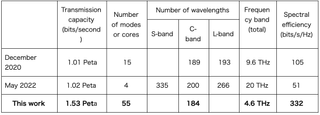Standard Fiber Optic Tech Achieves Record 1.53 Petabit per Second Transmissions
The entire world's internet traffic could fit inside a single fiber cable.

A team of researchers with the Network Research Institute of the National Institute of Information and Communications Technology (NICT, Japan) have achieved a new bandwidth world record over a single, standard-diameter optical fiber.
The researchers achieved a bandwidth of around 1.53 petabits per second by encoding information across 55 different light frequencies (a technique known as multiplexing). That's enough bandwidth to carry the entire world's Internet traffic (estimated at less than 1 Petabit per second) through a single fiber optics cable. That's a far cry from the gigabit connections we mere mortals have at our disposal (in the best scenarios): to be precise; it's a million times higher.
The technology works by taking advantage of the different frequencies of light available across the spectrum. Since each "color" within the spectrum (of visible and invisible light) has its own frequency that's distinct from all others, it can be made to carry its own independent information stream. The researchers managed to unlock a spectral efficiency of 332 bits/s/Hz (bits per second per Hz). That's a three-times higher efficiency than their best previous attempt, back in 2019, which achieved a spectral efficiency of 105 bits/s/Hz.

The researchers managed to transmit information on the C-band throughout 184 different wavelengths - the separate, non-overlapping frequencies that were made to carry information within the fiber cable simultaneously. Before being sent through the fiber optics cable, the light was modulated to transmit 55 separate data streams (modes). After modulation (and like most fiber optics cables currently deployed), it needed a single glass core to transmit all that data. When data is sent (across 184 wavelengths and 55 modes), the receiver decodes the different wavelengths and modes to gather their data. In the experiment, the distance between sender and receiver was set at 25.9 kilometers.
More attentive readers might remember that we recently covered a similar development - a prototype photonics relay that achieved a bandwidth of 1.84 petabits per second. That's higher than this research managed to achieve, but the problem with that solution is that it emplys a photonic chip that's still in the experimental design stages. As such, this particular research is likely to be deployed much sooner (it only requires that the fiber optics infrastructure be slowly upgraded to its design). It would also seem that it already makes more financial sense, as the difference between the entire world's traffic and the 1.54 petabits/s transmission rates (I have to reinforce that it happens over a single, standard diameter fiber optics cable) still leaves that much bandwidth on the table. And considering the number of wavelengths the researchers employed in past experiments (but not this one), there's a clear way to scale bandwidth further into the future.
For further information about the record 1.53 petabits/s data transfers, you can check out the official NICT press release, which is filled with technical details close to the bottom of the page.
Stay on the Cutting Edge
Join the experts who read Tom's Hardware for the inside track on enthusiast PC tech news — and have for over 25 years. We'll send breaking news and in-depth reviews of CPUs, GPUs, AI, maker hardware and more straight to your inbox.

Francisco Pires is a freelance news writer for Tom's Hardware with a soft side for quantum computing.
-
brandonjclark I wonder how they achieved this speed, given the theoretical maximums of negative slope diversion compensation techniques, being that DCF is essentially un-tunable.Reply
Most Popular


